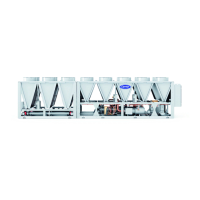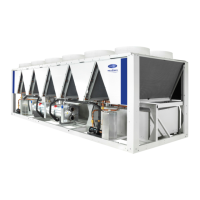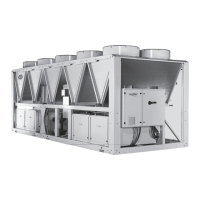27
The CCN communication port for the Master and Slave
chillers must be joined using a shielded cable in order to avoid
communication issues.
The master/slave linkage will not be allowed to operate if
any one of the slave chiller CTRL_PNT, DEM_LIM,
LAG_LIM, or LCW_STPT variables has a force priority
higher than a control force. In that case, the master/slave opera-
tions will not be allowed or will be disabled.
The control algorithm relies on several parameters that must
be field configured for operation. Both chillers must be on the
same CCN bus with different addresses. On both chillers, Mas-
ter/Slave Select (Main Menu Configuration Menu Mas-
ter Slave config Master/Slave Select) must be enabled (set
to 1 or 2). The water piping arrangement must be specified
with the Chiller in Series variable (Main Menu Configura-
tion Menu Master Slave config Chiller in Series). The
Master chiller must be programmed with the Slave Address
(Main Menu Configuration Menu Master Slave config
Slave Address). Additional optional programming parame-
ters may be configured to meet application requirements.
The Lead Lag Select variable (Main Menu Configura-
tion Menu Master Slave config Lead Lag Select) deter-
mines which chiller is the lead machine. The options are: Al-
ways Lead, Lag Once Failed Only, and Lead/Lag Runtime Se-
lect. Under Runtime Select control, the lead chiller will change
based on the time increment selected in the Lead/Lag Balance
Delta configuration (Main Menu Configuration Menu
Master Slave config Lead/Lag Balance Delta). If the run
hour difference between the master and the slave remains less
than the Lead/ Lag Balance Delta, the chiller designated as the
lead will remain the lead chiller. The Lead/Lag changeover be-
tween the master and the slave chiller due to hour balance will
occur during chiller operating odd days, such as day 1, day 3,
and day 5 of the month, at 12:00 a.m. If a lead chiller is not des-
ignated, the master chiller will always be designated the lead
chiller.
The dual chiller control algorithm has the ability to delay
the start of the lag chiller in two ways. The Lead Pulldown
Time parameter (Main Menu Configuration Menu Mas-
ter Slave config Lead Pulldown Time) is a one-time time
delay initiated after starting the lead chiller, before checking
whether to start an additional chiller. This time delay gives the
lead chiller a chance to remove the heat that the chilled water
loop picked up while inactive during an unoccupied period.
The second time delay, Lead/Lag Start Timer (Main Menu
Configuration Menu Master Slave config Lead/Lag Start
Timer) is a time delay imposed between the last stage of the
lead chiller and the start of the lag chiller. This prevents en-
abling the lag chiller until the lead/lag delay timer has expired.
A quicker start of the lag chiller can be accomplished by
configuring the Lag Unit Pump Control parameter (Main
Menu Configuration Menu Master Slave config Lag
Unit Pump Control). If the difference between the common
leaving water temperature and the set point is greater than the
configured value, then the lag chiller will start.
A minimum on time for the lag chiller can be pro-
grammed with the Lag Minimum Running Time configura-
tion (Main Menu Configuration Menu Master Slave
config Lag Minimum Running Time). This parameter
causes the control to run the lag chiller for the programmed
minimum On time. The Lag Unit Pump Control (Main
Menu Configuration Menu Master Slave config
Lag Unit Pump Control) can be configured such that the
pump can be on or off while the chiller is off. This parame-
ter is only active in Parallel Chiller Operation.
The lead chiller is started first and the lag chiller will be
maintained at zero percent capacity through master forcing
the lag demand limit value (LAG_LIM) to 0%. The lag wa-
ter pump will be maintained off. When the lead chiller can-
not be loaded anymore (because it is loaded at its full avail-
able capacity or at the master demand limit value) then the
lag start timer is started. When the lag start time has
elapsed, if the error on the master controlled set point is
greater than the dead band (start_di) and if the pulldown
time is elapsed then the lag chiller water pump will be
turned on (if required by configuration) and the lag chiller
will be allowed to start through the master chiller forcing
the lag chiller demand limit value (LAG_LIM) to its own
demand limit value. To ensure that the lag chiller will be un-
loaded first in case of water load decrease, the lead chiller
Fig. 24 — Initial Compressor Loading/Unloading Method
NOTE: After compressors are fully loaded, they will both load and unload
equally with the VFDs (variable frequency drives).

